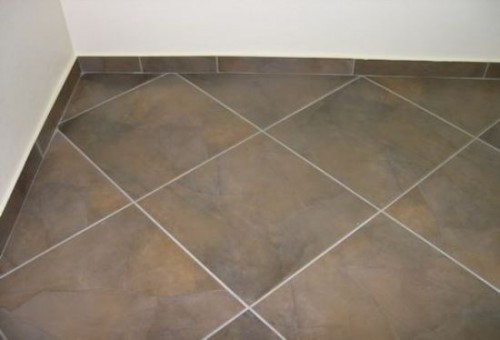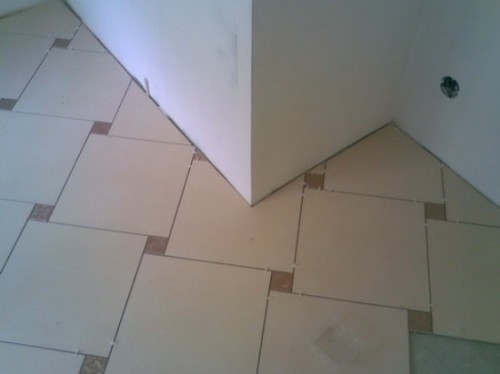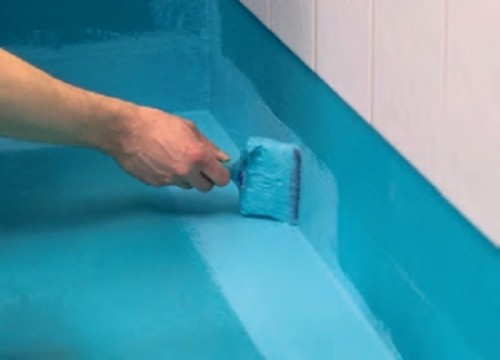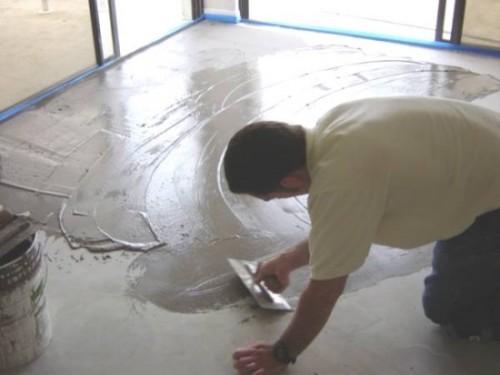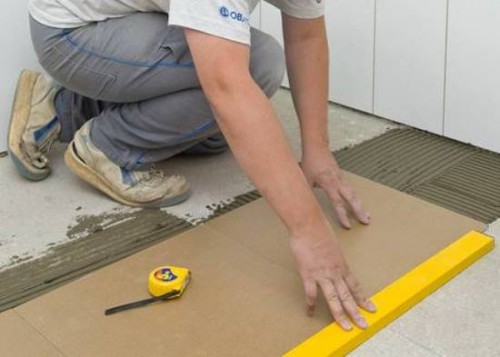Tiles are most often used to repair the bathroom. Today, there are so many manufacturers of this material that the buyer is unlikely to feel that his choice is limited. Different textures, shapes, colors and dimensions - everyone can choose tiles to their taste. Consider some of the subtleties of choosing this material, as well as in stages the procedure for laying tiles for the bathroom.
Content
How to choose tiles
Today on sale there is a wide variety of tiles. Therefore, it is very difficult for an unknown buyer to choose something suitable for himself. Another serious problem is to determine the right amount of tile, i.e. Buy as much material as necessary for work. Sometimes, to perform work, there is not enough acquired tiles, and you have to go to the store again. Sometimes they overpay and buy more than necessary. Moreover, overpayment is serious. At least for this reason it is worth buying tiles in large stores. After all, they can often take her remains back without any problems. In any case, it is better to buy the material more than it is necessary, because it is much more difficult to decide how much you need to buy. Moreover, it is likely that the store will not be replenished with the product you need, and your repair may remain unfinished for a long time.
But you also need to buy tiles with excess wisely. Previously, be sure to make the necessary measurements of the surface, which is planned to be faced with tiles. The material should be taken with a margin, but no more than 5% more. If you came to the store and chose the tile suitable for you, then be sure to ask the seller whether it is at a sufficient quantity at the store. In general, it is better to choose the right material even before measurements, especially if you plan to use expensive goods. When you know the sizes of the desired tile, then take a piece of paper and schematically draw your bath plan. This plan should be deployed, where each wall is depicted separately. At the same time, so that there are no errors in the calculations, it is important to observe the scale. Make a calculation not by square meters, but by the number of tiles. When the plan is ready, you can apply the contours of the tile to the walls.
Unfortunately, the sizes of the floor and walls are rarely multiple of the size of the tiles. Therefore, (most often for the angles of the room) the material will have to be cut. Mark the place for which the tile will be cut on the plan, while choosing them in such a way that the cut tiles are least noticeable. If you correctly calculate the plan, then you thereby reduce the amount of cut material. When the plan is ready, you can calculate the required amount of tiles.
Preparation of the premises
When all the necessary material is bought, we proceed to the preparation of the room. First of all, you need to take out furniture from it. She will interfere hard. In addition, be sure to block the valves from hot and cold water. Also with caution, remove the plumbing, especially if you do not plan to change it.
In the prepared room, the walls and floor can already be lined with old tiles. This tile needs to be removed. For this purpose, the punch set in shock mode is most suitable. But before starting work, this tool is advisable to beat off the lower tile manually, for example, through a bite. Do not worry about the fact that some old tile will fall off with pieces of plaster and glue. In any case, this layer will have to be removed.
Methods of laying tiles
Before you engage in laying tiles, it is necessary to take into account the ways of laying it, which there are several.
The simplest way is direct styling, which is most suitable for beginners.
In order to get a rather spectacular final surface in a square -shaped room, it is better to use diagonal styling. This method helps to mask oblique surfaces, but it requires experience.
The classic option for laying tiles of two colors is the styling in the form of a chess pattern.
Another styling method is to lay a displacement. In this case, each subsequent series of ceramic material is placed with some displacement in relation to the tile in the previous row. This option is well suited for use in rectangular rooms.
The material can be laid out in the form of mosaics from tiles of various sizes and colors. This is a rather complicated option that requires experience. At the stage of drawing up the plan, it is necessary to note the places where the inserts, borders and other decorative details will be located on it. When drawing up the plan, you need to strive to ensure that at the doorways and in the corners there are as few narrow strips of tiles as possible.
Tools and materials
For work, we need glue for ceramic tiles. It is a dry mix of water. The container in which you will prepare this glue will also be needed. For mixing you will need a drill. Even in the process, a building level and a spatula with a clove are necessary in the process. In order to remove excess glue, you will need a sponge. For cutting tiles - a grinder or tile cutter. The edges of the cut tiles will have to be grinded. To do this, a corundum block will be needed. In addition, in the process of work, you will need to form seams between the tiles. For this purpose, plastic crosses will be needed. At the end of the repair, you will need a grout for the seams.
Waterproofing
In the process of laying tiles, such an element as waterproofing is important. Some who think about whether the tile is needed under the bathroom is underestimated and simply ignored. But knowledgeable people recommend waterproofing in any room where water supply and water supply are installed. After such works, you will protect from the flow of water not only yourself, but also your neighbors.
Before installing the tiles, it is necessary to apply a special waterproofing coating to the floor. As waterproofing, you can use protective materials that are applied using glue. Before applying a waterproofing layer, you need to treat the surface with a primer. It will provide good grip of the protective layer on the floor. Then you need to apply the waterproofing layer itself. There are several ways for this. One of them is the coating method of application. It is perfect if you need to protect only the floor from moisture. To do this, the dry mixture of the material is diluted with water until a homogeneous mass is obtained. When the mixture is ready, you should apply it to the floor with a special roller to flat sections. In hard -to -reach places, the mixture should be applied with a spatula. In joints, it is best to lay a waterproofing tape. Waterproofing should also be applied to the walls, taking into account the value of the planned floor. The protective layer must be applied in several stages. After applying the next layer before applying the next one, you need to wait for five to six hours. After applying the last layer, you should leave the finished floor for a day. Understanding the importance of waterproofing of the floor should not cause a question whether the tile is put under the bathroom.
There is also a paint method for applying waterproofing. This is an easier and more convenient way, but less durable (service life of up to five years). In this case, a special waterproofing emulsion applied to the working surface is used using a roller.
Setting the floor
To lay the material on the floor, a high -quality screed is required, which will guarantee that the tile under the bathroom will fall evenly. In addition, further work is much easier to do when the surface is laid quite evenly. It is advisable to align the floor with the help of building special mixtures. In order for moisture not to fall into hard -to -reach places, and so that it does not accumulate there, it is better to make the floor under a small slope. To do this, you can make the horizontal levels around the perimeter of the walls, and then put the guide rails.
When the screed is ready, the floor should be poured with a special leveling mixture, which can be bought at any construction store. There are some nuances when laying tiles on a wooden floor. The fact is that such a floor without a screed and waterproofing will not last long, because moisture will fall into it. The filling should be started from the far end of the room and gradually move towards the door. The solution must be distributed evenly. After the work, the floor should be left for three days so that it can completely dry. Before putting tiles under the bathroom, it is recommended to uninstall the working surface, so that the clutch will improve.
Laying tiles under the bathroom
- Ceramic tiles are usually used to lay the floor. Before gluing the tile, it is advisable to just put it to start and see how it will lie. You will have to cut the tile in any case. Such chopped material is best distributed as close to the edge as possible. To lay the tile, it was easier, it is recommended during the fitting of the tiles, using a conventional marker or chalk, draw a marking on the floor.
- Start laying from the farthest corner. For work, previously diluted special glue is used. This glue should not be applied to the tile, but on the floor with a gear spatula.
- Then the material is tightly pressed to the surface and tapped along the entire edges with a hammer. This should strengthen its clutch on the floor. Between the tiles you need to lay special crosses that form the seams. In addition, you will need wedges with which you can level the seams between the tiles. During work, be sure to control the evenness of the styling using the construction level.
- During operation, the remains of glue will always appear, which must be removed from the surface as quickly as possible until it has dried. Otherwise, you can complicate your work.
- When the main whole tiles were laid, you can cut the required amount of material using a tile cutter or using a hacksaw on metal. We lay chopped tiles to previously intended places. When the material is already tightly laid to the surface, the seams should be sealed with a sealing composition.
- After the tile is completely laid, it is necessary to wait about three days, until the glue and the grout completely dry. When everything is dry, you need to wash the floor with a damp sponge, and then remove the excess sealing composition.

